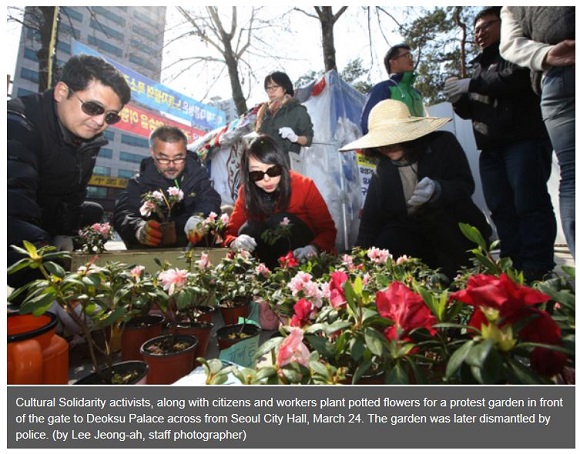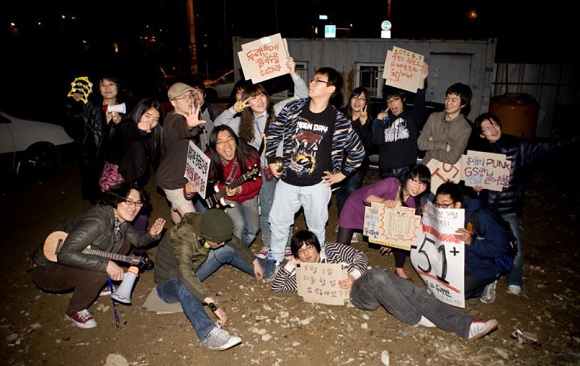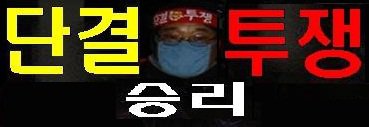공지사항
-
- '노란봉투'캠페인/국제연대..
- no chr.!
Today's Hankyoreh published the following piece:
Farming, knitting, live music: new trends in protesting

Young people move away from confrontational tactics of the past when holding public demonstrations
Shin Hae-jin, 33, made her first visit to Dumulmeori organic farming village in Gyeonggi Province in spring 2011. Her longstanding desire to have her own farm was her top priority, coming ahead of her job and everything else. But since the Four Major Rivers Project began in December 2011 in the local area, her life has dramatically changed. Many activists from other provinces who wanted to save the farming village gathered there. Shin said, “They were my neighbors and we worked next to each other at the farming village. To see them lose their land due to the Four Major Rivers Project pushed me to become involved in the protest campaign.”
She said since then she became more interested and more involved in protesting. “It wasn’t like violent resistance, but more like enjoying every day. I didn’t feel forced to become involved or anything like that.”
Shin majored in art at university and has never spoken out about political issues before. She was more used to painting than raising her voice, planting young rice seedlings instead of holding picket signs. Continuing with her farming during the protests in summer 2011 was another way for her to resist, while expressing herself artistically. Nowadays it is less common to see protest camps with shouting and picketing. A variety of ways to communicate with citizens and show ideas is now being used: farming, knitting, gardening, and holding small concerts.
These are all new trends for occupy demonstrations. The experimentation with new protest methods - so called Direct Action - started from Cort and Coltech(i.e. Cort/Cor-tek struggle) instruments protest sites as well as dismissed Ssangyong Motor workers’ sit-in site. They succeeded in drawing young people’s attention and are now trying to change the concept and extend the boundary of ‘campaigning’.
Jeong Ah-ram, a 26-year-old office worker, visited a noodle restaurant, Dooriban, to see her favorite band in 2010 for the first time. Located in Donggyo neighborhood of Seoul’s Mapo District, the restaurant is a symbol of opposition to the redevelopment of the local area. Many independent musicians held concerts at the restaurant to draw young people’s attention and participation.

After people first participated in protests, they then became more and more interested. In March, Jeong also visited dismissed Ssangyong Motor workers’ sit-in site at the entrance to Deoksu Palace near Seoul City Hall. She did not bring picket signs, but instead brought a ball of thread for knitting. She heard the news that the burned-down camp site would be newly replaced with a Garden of Protest. She also heard people would sit on streets and knit as a ‘knitting protest’... (a related contribution you'll get here!)
Although the day was getting hotter, she was more than willing to spend her weekend knitting as part of the campaign. There were also many other people who came along and joined the knitting protest after it spread on Twitter...
Shin Yoon-ah, an activist from Cultural Solidarity, who organized the knitting protests, said, “Vigorous protests do not appeal much to the public nowadays. In the past, the main actors at protests have always been the victims or those closely related to them, which often caused some adverse reaction from the public. People glanced coldly at those protesters on the street. That’s why I always try to come up with something new and creative that can closely involve other citizens”.
Of course, there are some people who say the interest from young people is only temporary. However, Im Jeong-hee, a professor at Yonsei University’s College of Humanities & Arts does not share that view. Im said, “Young people’s interest in direct action is often improvised, but it’s not arbitrary. Also, their thoughts on social issues like labor and the environment are not set, like activists of the previous generation. But still they are volunteering to become involved, for example going to Jaenueng Education protest site in Seoul or visiting the anti-transmission tower protest site in Miryang. There, they realize the virtues of community ethics while learning how to share and communicate with other people.
After all, this might be a kind of everyday political protest against the hard reality. Jeong described it as metaphoric and circuitous resistance. "Unlike the older generation who participated in the Democratization Movement and had to fight against the regime for their lives, today’s younger generation, including myself, clearly has a different experience. Instead, we have a new culture of demonstration. We therefore try to tackle the invisible but suppressive powers using our new methods."

최근 덧글 목록